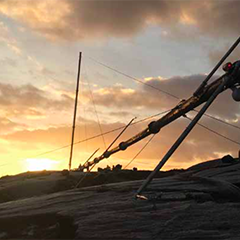How do you install two 80 metre masts on a hill of rocky terrain in Norway? You enlist the experts. Here, Dulas Site Manager Bob Sharples recounts his experiences of being part of the team that took part in this fascinating and eye-opening recent project.
With a history spanning over thirty years and experience of working across the globe, Dulas seemed like a good choice for the installation of a global wind company’s new masts; especially with our 2012 acquisition of Chillwind.
As part of our commitment to providing renewable energy on a worldwide scale, we pride ourselves as veterans of overcoming challenges to contribute our award-winning skills to a variety of projects; with connections as close as home in Wales and as far away as Africa. With this in mind, it was great to see that our previous good work was recognised in Norway, as we were called upon to tackle the mammoth challenge in question: the installation of two 80 metre masts as part of a developing wind farm.
Despite early worry that the height may not even be feasible, an assessment was carried out and the project was deemed safe enough to continue on in our capable hands, so we ventured in to the hills of Egersund, a town on the western coast of Norway, while equipment and kit was sent from our Inverness base with the help of our logistics team. A Plan B was of course put in place by Dulas specialists, but in the end was thankfully deemed unnecessary.
The project involved navigating frozen terrain and arriving on site at first daylight – though the weather could swing from hail to sunlight, it was important to press ahead through the ever changing elements and to the challenge ahead.
And what a challenge it proved to be – the unusual circumstances of the site proved it too difficult to lift the mast with conventional plant equipment, meaning we had to call in another special team member: a helicopter. This was used for both crew transportation and mast suspension, meaning that the skill of working at height was absolutely essential to this task. The tripod method of lifting on difficult terrain was challenging with swinging at height, and the mast bending and flexing was another facet that contributed to the demanding nature of the task.



























